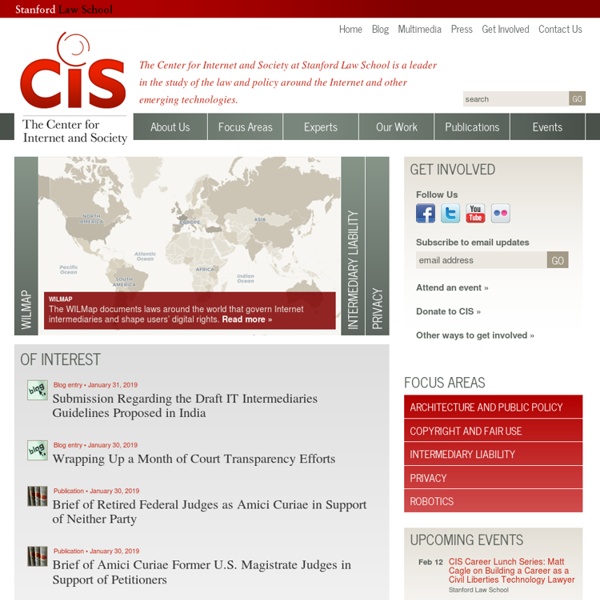



The Debate Over Internet Governance: Introduction Welcome to the Debate Over Internet Governance: A Snapshot in the Year 2000 This website was prepared as a final project for the course Internet & Society: The Technologies and Politics of Control at Harvard Law School. This site aims to do that which might seem impossible in a medium that changes so quickly and so dramatically to freeze a particular moment in the debate over internet governance. [Note: as of May 2005, the legal landscape has continued to change. The moment we seek to capture here is no ordinary moment in the development of the internet. At some level, even those most wary of formal governance for the internet recognize the need for central administration of some of the internets technical aspects. If nothing else, what is clear is that the decisions made today about the technical architecture of the internet and the body which will administer that architecture will shape the internets development for years to come. As the expiration of NSIs contract with the U.S.
SearchWorks (SULAIR) Freedom to Tinker | Hosted by Princeton's Center for Information Technology Policy National Advanced IPv6 Centre of Excellence The Internet represents as one of the most successful examples of sustainability and its benefits owing to the continuous investment and commitment to research and development of Information infrastructure. The Internet today as a widespread information infrastructure involves many aspects; technological, organizational and community. It has influenced not just computer communication but the entire society ranging from e-commerce to information acquisition and community operations. Commercialization of the Internet changed the landscape completely. It created a market for global data delivery service. The Internet has evolved and evolving, bringing new applications, services, new technology and products. With growing interest in use of the Internet the number and type of stakeholders involved has increased. The Internet today has evolved from a research-based closed network to a critical, public and commercial infrastructure used by all.
Brains in Silicon Welcome to Brains in Silicon. Learn about the lab, get to know the brains that work here, and find out about new projects that you could join. We have crafted two complementary objectives: To use existing knowledge of brain function in designing an affordable supercomputer—one that can itself serve as a tool to investigate brain function—feeding back and contributing to a fundamental, biological understanding of how the brain works. We model brains using an approach far more efficient than software simulation: We emulate the flow of ions directly with the flow of electrons—don't worry, on the outside it looks just like software. Welcome and enjoy your time here!
Silicon Flatirons - A Center for Law, Technology, and Entrepreneurship at the University of Colorado IGF Related Links Stanford University Press About | Symposium Website To learn more about the host institution please visit its current beta website. On the 1st Symposium on Internet and Society we were welcoming Internet & Society scolars from all disciplines to exchange perspectives and deliberate about the best ways to research and shape the transformation of our societies caused by networked information technologiy. The symposium consisted of three elements: The Inauguration on October 25th at the faculty of law at Humboldt University of Berlin was holding an evening reception and announced the scientific board and the board of trustees. We were welcoming David Drummond, Senior Vice President at Google. Finally, the directors announced details about the research approach of the institute and opened the institute space for a public view.The Research Symposium, October 26th and 27th, was a transdisciplinary academic conference which brought together researchers who are committed to work in the area of Internet and Society. Schedule Speakers Philipp Müller
gnarl » Internet governance After posting my previous ramblings on the subject of Internet Governance (IG) I’ve been quite busy in my head, thinking about where I stand on this subject and how best to define the various aspects of IG within the so-called «Nordic model» that applies to Government, Business and Citizen of Iceland, Norway, Sweden, Finland and Denmark (the Nordic countries). This time, I’m exploring parts of IG in the Nordics, as seen from Norway. First of all, I’m not so sure that the Internet are seen in the same way in the Nordic region as a whole. I might be wrong, but Finland seem to be ahead of both Norway and Sweden, with Iceland and Denmark fast approaching from behind. The WSIS Working Group (WG) on Internet Governance (WGIG), set up by the Secretary-General of the United Nations, after the first part of the WSIS in Geneva (2003) were asked to “investigate and make proposals for action, as appropriate, on the governance of the Internet by 2005″. So?
Stanford University Stanford University (officially Leland Stanford Junior University) is a private research university in Stanford, California, and one of the world's most prestigious institutions,[8][9][10][11] with the top position in numerous surveys and measures in the United States.[12][13][14][15][16][17][18] Stanford was founded in 1885 by Leland Stanford, former governor of and U.S. senator from California and leading railroad tycoon, and his wife, Jane Lathrop Stanford, in memory of their only child, Leland Stanford, Jr., who had died of typhoid fever at age 15 the previous year. Stanford was opened on October 1, 1891[2][3] as a coeducational and non-denominational institution. Stanford is located in northern Silicon Valley near Palo Alto, California. Students compete in 36 varsity sports, and the University is one of two private institutions in the Division I FBS Pacific-12 Conference. History[edit] Origins and early years (1885–1906)[edit] Foundation[edit] Physical layout[edit] Early finances[edit]